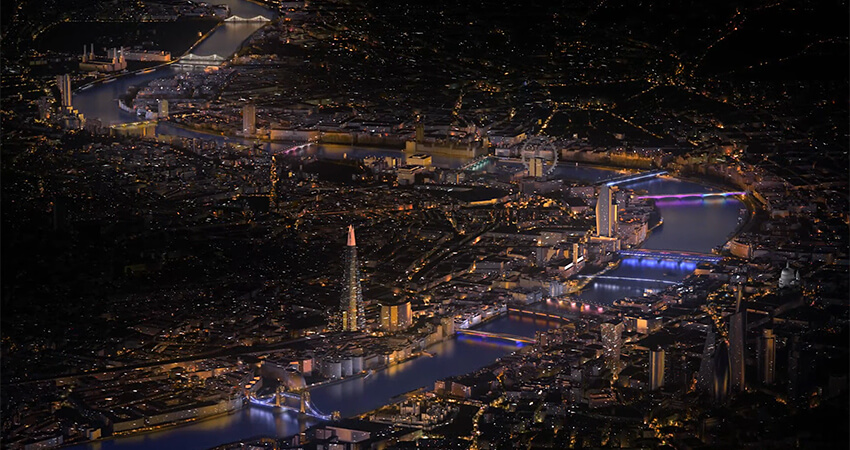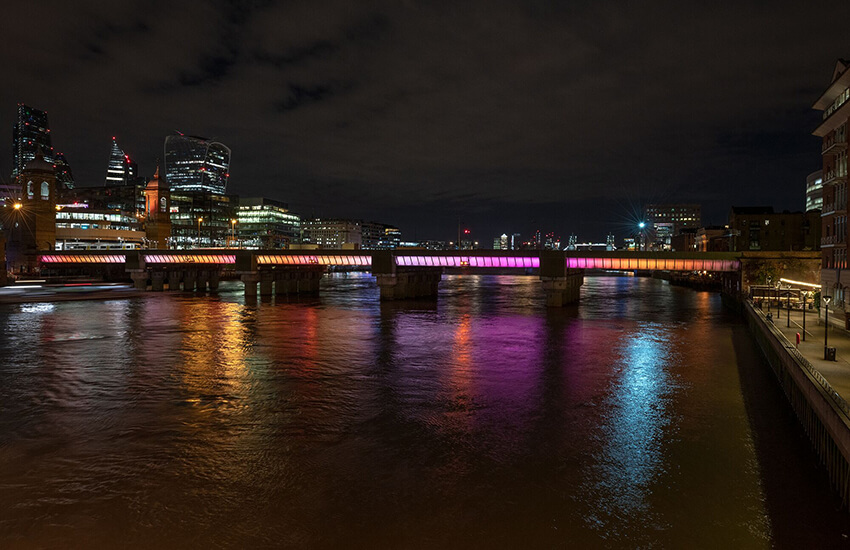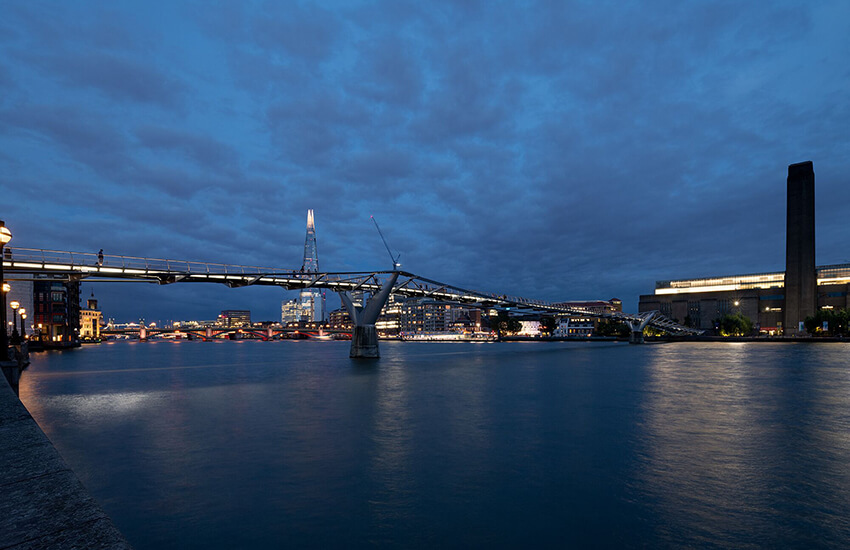Interview by Jack Apollo George

Add a sculpture to a town square, and you still have a town square. Put the same sculpture in an empty room, and you have yourself an art gallery. Public art is difficult to get right. Creating new experiences in existing urban spaces is not easy. This is because any such installation or performance depends on the approval of the political establishment. If you cannot wriggle your way through the requisite layers of bureaucracy, then you will not be able to see your idea come to life.
For this reason, most works, be they sculptures, statues, or light shows, have to rely on not being too risqué—neither offensive nor disruptive. It is difficult for the vitality of contemporary art to truly quiver when it relies on getting a signature from the mayor’s office. However, when the work is on a truly grand scale, enmeshing itself into an existing public space, the impact can be transcending. This is especially true when the materials used are as communal and every day as light itself. This is because the illumination of space and materials is something that everyone can respond to; it spreads and reflects, sparkles and fades out without recourse to language, history or culture. It allows for the most democratic of visual experiences.
With all that in mind, Illuminated River -a collaborative project to light up 15 bridges in London, one of the world’s great cities- should be able to create a terrific piece of public art by introducing something beautiful to see, useful to use and accessible to all. Pace Gallery will be presenting Leo’s first solo exhibition at Pace in London (on view from 22 November 2019 to 11 January 2020) to will coincide with the recent launch of Illuminated River.
One of the main creative forces behind London’s illuminated river product is the American artist and bona fide light sculptor Leo Villareal. A graduate of Yale University and NYU’s Tisch School of the Arts, Villarreal has long been interested in deploying the simplest modes of technology to engender entrancing experiences and reconfigure the way that people interact with and appreciate their environments.
While all of the visual arts are works utilising and making sense of light in some form, there is something in the purity of Leo Villareal’s works that make them so much more potent. He started getting to grips with technology early in his career and has not lost sight of the power of software to create immersive and replicable installations. Indeed, a lot of the time, he is working directly with the code that fuels his work. From the starkness of binary to the on/off functionality of a simple bulb, there is also a delightfully minimalist streak throughout his installations. These include 25,000 LEDs strung on the vertical cables of the San Francisco-Oakland Bay Bridge, a hypnotic giant football-shaped molecule (C60), and a 75-foot illuminated star ceiling between piers in New York City.
The thing with light is that it takes very little power or computational energy to create something mesmerising rapidly. A few LED lights, flickering on and off, is as simple a work as one could imagine, but also one that can adorn the walls of a gallery or the edges of a public landmark to reconfigure how visitors and bystanders experience that space completely.


In your work, you combine lights and encoded computer programming to create illuminated displays, but you also have a background in sculpture, and your works also have an architectural/spatial dimension. What attracted you to work with light?
For me, it was a long process. I studied sculpture at Yale University and finished it in 1990 when computers got more interesting and things like Photoshop were starting to come out. So that drew me, and not really knowing what I would do with that technology, I ended up going to the interactive telecommunications program at NYU in 1992.
I got very deeply involved in that, and then in 94, I went to work at a research lab in Palo Alto, California and ended up spending three years out there. I was an artist on the team. It was a very amazing research lab that combines engineers and programmers with musicians, designers, artists and shows, somewhat utopian. And eventually, I found my way to connecting software in life. That was a big moment for me.
What attracts you to light? What makes you want to work with light?
What’s interesting to me is that it’s kind of very primal. This is something that’s universal, and everyone can respond to it. It’s not really about language. It’s not about images. We’re deeply connected to light.
So that part of the connection is what I love about art, but then the software part connects to the technology aspect of it. So somehow, that connection was important to me because I didn’t want to work initially with representations of light with screens or projection.
Are you interested in the sense of altering/synaesthetic properties of light?
Yes, it’s powerful and connects deeply to our perceptions and our senses. I’ve been in several exhibitions; one called Visual Music that deals with the idea of Synesthesia, and remapping of the senses, a very nice show at the Hirschhorn in Washington, DC.
One of the pioneer artists working with light and using its mutating capabilities was James Turrell. Has his work been an inspiration for you? If so, in what way?
Yes, he was. I saw their work in the early nineties. For the first time when I went to visit, uh, I went to see The Panza collection at Villa Menafoglio Litta in Varese, Italy. The collection was installed in his stables, and it was the first time I saw Turrell’s, Dan Flavin’s, Bruce Nauman’s, and Robert Ryman’s work. Work that changed my thoughts about what art could be minimal. But I thought I’m going to do this differently and I added the element of computation, programming, and structures.
Is minimalism also part of your work? Computing is mainly ones and zeros…
I do think that there is a small number of ones and zeros only when is necessary to create these works, so there is a sense of minimalism in that way. Oftentimes I’m interested in just working the code. Sometimes I use monochromatic light, and that sort of focuses more on the sequencing and the programming aspects.
I really like paring things way down to the minimum. I’m interested in small amounts of information in ways that those things can be very evocative.
That was one of the big Epiphanes I had down; a small amount of information could be very powerful. I felt that was a very lonely kind of experience, and I was interested in more of these communal experiences with groups of people I realise that I could create work that could have this ability to transport people.
Did I read something about you at Burning Man?
Yes, I’ve been keeping going, and this will be my 26th year. I feel nothing that can encapsulate how it feels. It’s really very powerful, and it’s misunderstood. It is very intensive.
Have you had pieces there?
I have. I mean, the first light sculpture I ever made. It was a beacon so I could get oriented. At this point, it was more about me working with a group, with my camp and less about my work specifically.
Talking about digital environments (augmented and virtual realities), can you see taking your work into these new realities or these new realms? Have you thought about that?
Yes, it’s fascinating, and I’m very interested in VR and AR. We do a lot of work to visualize installations and use them in a very kind of practical way in my studio. As a tool, for is very powerful but as artwork there on its own.
That’s not something that we’ve worked on. We’ve done a few experiments. My interest is more like bringing these kinds of digital experiences out into the world.
You have built pieces for both galleries and open spaces; what do these different setups bring to your practice or artworks? What role does space have in your practice?
I established my studio in 1998 in New York, and it’s been over 20 years of working and making light sculptures. It all started out as my kind of alone in my studio with one or two assistants or two, having gallery exhibitions and working with museums, and then I started to work on a public artwork scene in 2003.
So that just becomes another area of interest. I love working on these really large scales, like The Bay Light in San Francisco or the Illuminated River project in London; those are tens of millions of people to get to experience the artwork, which is really very exciting.
Those large-scale projects take a lot of time and money, and a lot of, you know, because there’s a lot of things you have to do in order to get to that panel point of realization. I might learn something on a large constellation, which I can then apply on a smaller scale piece or vice versa. So it’s all one big fluid continuum, and I really like having that balance.
One of your main interests is the visual manifestation of the code in light. Which of the most recent technological advancements has been more fruitful for the development of this part of your work?
In my early, early pieces, I was using strobe lights and light bulbs. And then eventually ended up working with lead, which obviously was amazing because it’s solid-state lighting and it has very durable uses, very little energy, and you can make 16 million or more colours, so it’s a very pretty incredible material. I coupled that with my custom software -for years, we’ve been writing our own custom code that creates these sequences.
The first pieces I made were using simple microphones from zero to 100. And then, as things got more complex, it got beyond what I could do myself, and I started working with different programmers. So it’s been an interesting progression, I’m not custom-writing the tools myself, but they’re being made for me to my specification. We have our own little research lives where we keep these tools, so everything I’ve made is using that, and that is something I think is very special and also distinguishes my work.
Recently we’ve started to work with led panels, and we’re making pieces with 3K displays, which is 24 million pixels. And I’ll be doing these randomized sequences and generative patterns that are computationally very, very intensive, so we’re using the most powerful computers we can get in order to do a lot of these things. So I’m doing some new explorations and not just the led arrays, but actually starting to work with some new display technology as well.
Let’s talk about the Illuminated River. What was the intellectual process behind the inception of the project?
I think it was a very complicated project. In London, there are up to 15 different bridges that are considered very historic. There are iconic bridges like Tower Bridge and others more utilitarian like rail bridges and road bridges, and they all served the same functionality to get from A to B across the river.
There are moments in time in terms of their engineering and their style of them that trying to create a sense of continuity between them was quite challenging. We started with each individual bridge understanding how this bridge has been illuminated historically.
We were able to speak to Foster & Partners about the Millennium Bridge and to Lifschutz Davidson Sandilands about the Golden Jubilee Footbridges. We worked very closely with them. Then we started to think about how we could add some things to activate the bridge with the lights. It’s not just architectural lighting it’s all changing and moving. There’s a dynamic element to the light. And that movement is inspired by the kinetic activity when you’re on the river, whether it’s the movement at the time, the drops in the boats, all these things.
But it’s not using any kind of sensors. It’s not literally interactive. But people still feel a sense of connection between you see these things in their brain, and can’t help but match these powders together cause we can’t help it recognize patterns, or create connections. So it’s kind of happening very subjectively with HBR.
How do you expect it will impact the city, or what do you expect it to bring to the viewers?
I think the goal is to transform the way people see bridges because a lot of people just walk by and don’t really notice these things, and this will bring them to life in a way. It’s a different perception of the surroundings. It’s about helping people to perceive beauty.
What are the biggest challenges that you and the team are facing?
Working in the middle of a very busy city with traffic and boats on these pieces of infrastructure that everyone’s using and not being able to impact that traffic is very challenging. So we had our sailors hanging off the bridges, and installing lights was a very physically very challenging thing to do. And also, we 3D scanned all the bridges working with very elaborate virtual reality simulations.
But things are always a little bit different than in the actual physical world. We have birds nesting in a certain location where we want to do this all lights, and we had to wait for the two baby birds. So it’s just a lot of complexities, but we had a very professional team of people that did it, and we managed to complete the installation and install the fibre optic cables because that the pieces all network together even in London.
There’s this sense of synchronicity between them, so that creates this connection. It’s been challenging on so many levels, like creating this custom software that helps me to create the patterning patterns in the sequences and displays the same things and also creates connectivity.
Apart from this project, what’s in for 2020?
We’re going to try to do five more bridges for next year. We will do an exhibition at PACE Gallery in London in November and then one in Palo Alto in, California, in April next year. And we have many commissions happening in San Francisco and Frankfurt.
What is your chief enemy of creative creativity?
Monotony things that are just become very routine and you don’t see. I think you need to see new things, and that’s what I’m trying to take.
You couldn’t live without…
All the community people I have around me, a wonderful family, friends, and collaborators in my studio.






